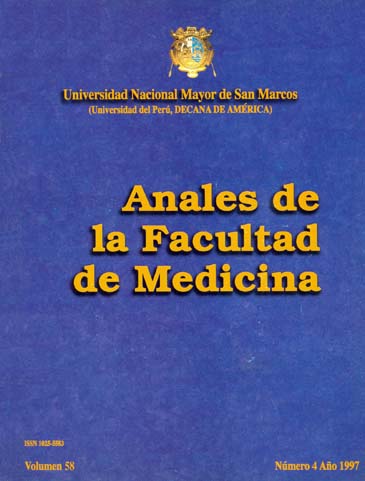Enterococcus in routinary microbiology work
DOI:
https://doi.org/10.15381/anales.v58i4.4655Keywords:
Cross Infection, Enterococcus, Microbiological Techniques, AmpicillinAbstract
In the last years, importance of Enterococcus has been increasing because it is now known as causal agent of difficult-to-treat nosocomial infections, mainly due to their antimicrobial resistance. We identified Enterococcus strains using selective media to isolate it, differential assays for strains identification, and standarized disk-diffussion methods to assess antimicrobial susceptibility. Between march and november 1996, 113 strains of Enterococcus were isolated, 65,4% of which come from vaginal discharges, and the remainder from seminal fluid, urine specimens, faringeal secretions, ascitid fluid, sputum, skin wounds samples, prostatic fluid and uretral fluid. E. faecalis give a total of 88,5% of isolates, followed by E. faeccium, E. pseudoavium, E. avium, E. durans y E. raffinosus. Antibiogram analysis using 13 antimicrobial single drugs and another 2 combined with betalactamase-inhibitors, showed that 97,3% of Enterococcus were ampicillin-sensitive. We concluded that isolated Enterococcus strains show, up to now, a small resistance to ampicillin.Downloads
Published
1997-12-31
Issue
Section
Trabajos originales
License
Copyright (c) 1997 José Guevara D., Juan Guevara G., Esther Valencia, Hércules Alcalá, José Guevara G.

This work is licensed under a Creative Commons Attribution-NonCommercial-ShareAlike 4.0 International License.
Those authors who have publications with this magazine accept the following terms:
- Authors will retain their copyrights and guarantee the journal the right of first publication of their work, which will be simultaneously subject to Creative Commons Attribution License that allows third parties to share the work as long as its author and its first publication this magazine are indicated.
- Authors may adopt other non-exclusive licensing agreements for the distribution of the version of the published work (eg, deposit it in an institutional electronic file or publish it in a monographic volume) provided that the initial publication in this magazine is indicated.
- Authors are allowed and recommended to disseminate their work over the Internet (eg: in institutional telematic archives or on their website) before and during the submission process, which It can produce interesting exchanges and increase quotes from the published work. (See El efecto del acceso abierto ).
How to Cite
1.
Guevara D. J, Guevara G. J, Valencia E, Alcalá H, Guevara G. J. Enterococcus in routinary microbiology work. An Fac med [Internet]. 1997 Dec. 31 [cited 2024 Jun. 30];58(4):245-9. Available from: https://revistasinvestigacion.unmsm.edu.pe/index.php/anales/article/view/4655















